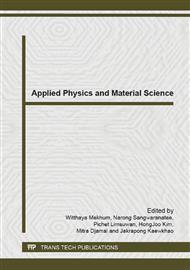p.200
p.204
p.208
p.212
p.216
p.220
p.224
p.228
p.232
Low-Cost and Fast Production of Nano-Silica from Rice Husk Ash
Abstract:
Silica with nanostructure are the high quality silica that are used in many industry areas. The applications of silica nanostructure frequently depend on physical properties such as morphology and size of structure. Rice husk ash is the waste from biomass power plants and is a high quality, raw material as a silica source. The conventional methods for synthesis of nanosilica from rice husk ash are energy consumption or time consumption. The objective of this work was to investigate the synthesized of nanosilica from rice husk ash via sodium silicate solution. nanosilica particles were obtained via alkaline extraction and a fast acid precipitation method at room temperature by adding inorganic salts and without surfactant or template. The flow synthesis was investigated at ambient temperature, varying the concentration of hydrochloric acid, sodium chloride, and flow-rate while fixing the concentration of sodium silicate. The samples were characterized by field emission scanning electron microscopy (FESEM), transmission electron microscopy (TEM), and X-ray diffraction (XRD). The results revealed that the sodium chloride is significantly inorganic salt for generated nanosilica, with uniform spherical morphology (80-150 nm), without curing or aging time. In the flow synthesis method, the silica nanoparticles, of diameter around 10 nm and aggregate particles of around 50 to 200 nm, were obtained. This method may be applicable to control different grade of silica and can easily scaling up of silica production for different industries.
Info:
Periodical:
Pages:
216-219
Citation:
Online since:
June 2014
Authors:
Keywords:
Price:
Сopyright:
© 2014 Trans Tech Publications Ltd. All Rights Reserved
Share:
Citation:


